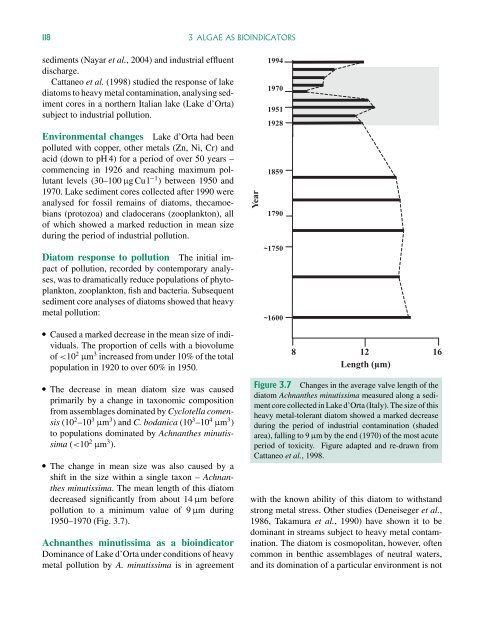118 3 ALGAE AS BIOINDICATORSsediments (Nayar et al., 2004) <strong>and</strong> industrial effluentdischarge.Cattaneo et al. (1998) studied the response of lakediatoms to heavy metal contamination, analysing sedimentcores in a northern Italian lake (Lake d’Orta)subject to industrial pollution.Environmental changes Lake d’Orta had beenpolluted with copper, other metals (Zn, Ni, Cr) <strong>and</strong>acid (down to pH 4) for a period of over 50 years –commencing in 1926 <strong>and</strong> reaching maximum pollutantlevels (30–100 µgCul −1 ) between 1950 <strong>and</strong>1970. Lake sediment cores collected after 1990 wereanalysed for fossil remains of diatoms, thecamoebians(protozoa) <strong>and</strong> cladocerans (zooplankton), allof which showed a marked reduction in mean sizeduring the period of industrial pollution.Diatom response to pollution The initial impactof pollution, recorded by contemporary analyses,w<strong>as</strong> to dramatically reduce populations of phytoplankton,zooplankton, fish <strong>and</strong> bacteria. Subsequentsediment core analyses of diatoms showed that heavymetal pollution: Caused a marked decre<strong>as</strong>e in the mean size of individuals.The proportion of cells with a biovolumeof
3.3 WETLANDS 119therefore directly indicative of heavy metal pollution.In spite of this, the presence of dominant populations(coupled with a decre<strong>as</strong>e in mean cell size)is consistent with severe environmental stress – <strong>and</strong>would corroborate other environmental data indicatingheavy metal or acid contamination.3.3 Wetl<strong>and</strong>sWetl<strong>and</strong>s comprise a broad range of aquatic habitats –including are<strong>as</strong> of marsh, fen, peatl<strong>and</strong> or open water,with water that is static or flowing <strong>and</strong> may be fresh,brackish or salt (Boon <strong>and</strong> Pringle, 2009). Many wetl<strong>and</strong>sform an ecological continuum with shallowlakes (Sigee, 2004), with st<strong>and</strong>ing water present forthe entire annual cycle (permanent wetl<strong>and</strong>s) or justpart of the annual cycle (se<strong>as</strong>onal wetl<strong>and</strong>s). Becausethe water column of wetl<strong>and</strong>s is normally only 1–2 min depth, it is not stratified <strong>and</strong> the photic zone (lightpenetration) extends to the sediments – promotinggrowth of benthic <strong>and</strong> other attached algae.Wetl<strong>and</strong>s are typically dominated by free-floating<strong>and</strong> rooted macrophytes, which are the major sourceof carbon fixation. Although growth of algae maybe limited due to light interception by macrophyteleaves, leaf <strong>and</strong> stem surfaces frequently providea substratum for epiphytic algae – <strong>and</strong> extensivegrowths of periphyton may occur. Wetl<strong>and</strong>s tend tobe very fragile environments, liable to disturbanceby flooding, desiccation (human drainage), eutrophication(agriculture <strong>and</strong> w<strong>as</strong>te disposal) <strong>and</strong> incre<strong>as</strong>edsalinity (co<strong>as</strong>tal wetl<strong>and</strong>s). Algal bioindicators of waterquality are particularly important in relation to eutrophication<strong>and</strong> changes in salinity – such <strong>as</strong> thoseoccurring in Florida (United States) co<strong>as</strong>tal wetl<strong>and</strong>sC<strong>as</strong>e study 3.1Salinity changes in Florida wetl<strong>and</strong>sIn recent decades, wetl<strong>and</strong>s in Florida have been under particular threat due to extensive drainage, with many ofthe interior marshl<strong>and</strong>s lost to agricultural <strong>and</strong> urban development. This h<strong>as</strong> resulted in a shrinkage of wetl<strong>and</strong>are<strong>as</strong> to the co<strong>as</strong>tline periphery. In addition to their reduced area, co<strong>as</strong>tal marshes in south-e<strong>as</strong>t Florida havealso suffered a rapid rise in saltwater encroachment due partly to freshwater drainage, but also to rising sealevels resulting from global warming.Studies by Gaiser et al. (2005) have been carried out on an area of remnant co<strong>as</strong>tal wetl<strong>and</strong> to quantify algalcommunities in three major wetl<strong>and</strong> ecosystems – open freshwater marshl<strong>and</strong>, forested freshwater marshl<strong>and</strong><strong>and</strong> mangrove saltwater swamps. The study looked particularly at periphyton (present <strong>as</strong> an epiphyte <strong>and</strong> on soilsediments) <strong>and</strong> the use of diatom bioindicator species to monitor changes in salinity within the wetl<strong>and</strong> system.Effects of salinity The major microbial community throughout the wetl<strong>and</strong> area occurred <strong>as</strong> a cohesiveperiphyton mat, composed of filaments of blue-green algae containing coccoid blue-greens <strong>and</strong> diatoms.Periphyton biom<strong>as</strong>s, determined <strong>as</strong> <strong>as</strong>h-free dry weight, w<strong>as</strong> particularly high (317 g m −2 )inopenfreshwatermarshes, falling to values of 5–20 g m −2 in mangrove saltwater swamps. Salinity had an over-riding effect onalgal community composition throughout the wetl<strong>and</strong>s. The filamentous blue-greens Scytonema <strong>and</strong> Schizothrixwere most abundant in freshwater, while Lyngbya <strong>and</strong> Microcoleus dominated saline are<strong>as</strong>. The most diversealgal component within the periphyton mats were the diatoms, with individual species typically confined toeither freshwater or saline regions. Dominant species within the separate ecosystems are listed in Table 3.8,with freshwater diatoms predictably having lower salinity optima (2.06–4.20 ppt) compared to saltwater species(11.79–18.38 ppt). Salinity tolerance range is also important, <strong>and</strong> it is interesting to note that that dominantdiatoms in freshwater swamps had higher salinity optima <strong>and</strong> tolerance ranges compared to other freshwaterdiatoms – suggesting that the ability to tolerate limited saltwater contamination may be important. Theconverse is true for the saltwater swamps, where dominant species were not those with the highest salinityoptima.
















